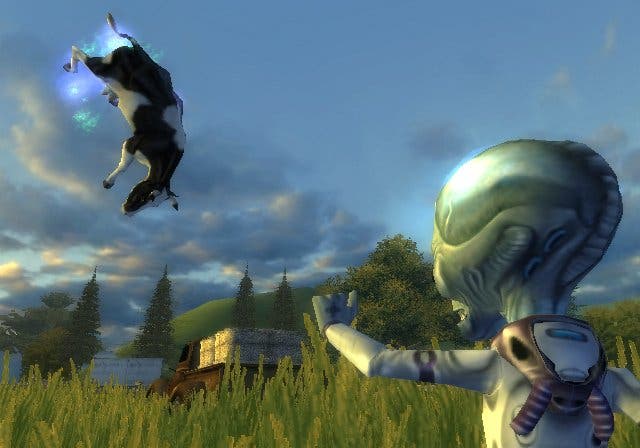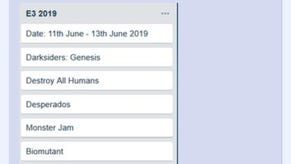Destroy All Humans
Alienation.
For a long time Destroy All Humans looked like it had the potential to be one of the games to look forward to this year. Full of smart humour, the hugely original premise turns the alien invasion concept on its head, puts you in the shoes of the bug-eyed extra terrestrial, sets it in the bubble-headed carefree environs of 1950s American suburbia and makes the 'pathetic humans' the villains for once. With flying saucer shoot-'em-up destruction, mind control, telekinesis, jackpacking, and holographic identity theft all in the mix, the game looks like a banker. Little wonder our early impressions of the game suggested nothing less than brilliance.
This loving homage to 1950s sci-fi gets off to a roaring start with a great back-story and hilarious opening salvo that sets the scene perfectly. The slightly agitated Furon people are a race with big problems: no genitals, and cloning issues. Quite how they ended up without reproductive organs is never fully explained, but suffice to say these midget, bug-eyed, grey-skinned aliens have realised that after successive generations of cloning they need to replenish their fast-deteriorating stocks of DNA fast. Having identified that Furon DNA is buried deep within the Human genome, Cryptosporidium 136 is sent on a mission to Earth to rob some unwitting humans of their brain stems and solve this Furon crisis.
Fists of Furon
Predictably, the mission goes awry when Crypto (as he is generally known as in the game) crashes his saucer in the middle of the desert. Staggering woozily out of his battered ship, before he's had time to focus his bug eyes on the crowd of US officials standing outside his wrecked craft, he collapses in a heap and inevitably gets whisked off to a top-secret research facility. With all this alien technology having fallen into the wrong hands, the Furons send a succession of clones to Earth to put a stop to the human's meddling, as well as topping up their harvest of DNA.
Landing in the middle of Turnip Seed Farm on the hunt for the dominant life form, Crypto has the distinct misfortune of landing right next to a herd of Cows. At this stage unaware of what the humans look like, he wastes no time in expressing his utter contempt of everything he sees ("but they're covered in nipples!"). With one scowling Jack Nicholson-in-a-bad-mood quip after another, he scans their thoughts ("Mooooooo!") before declaring "I don't care how many stomachs you have!" at the sight of a giant cowpat emerging, before flinging their foul-smelling, leg-kicking torsos across the farm with his powerful psychokinetic abilities.
This, of course, attracts the attention of the shotgun-wielding yokels at the nearby farm. Cue a quick burst of electric death with the Zap-O-Matic, brain extraction and general PK fun, which in turn causes the military to arrive en masse (complete with an assortment of tanks) to deal with the 'disturbance'. Heavily outnumbered and out-gunned, your only viable option is to leg it to your flying saucer and take them all out with your fiery Death Ray, destroy all the buildings in the area and get the hell out.
Fair enough

Moving on quickly through the six main locations, the game progresses at a rapid pace through 20-odd story missions that may take less than ten hours to complete. Taking in a fairground (Rockwell), small town suburbia (Santa Modesta), a desert base (Area 42), an industrial dock (Union Town) before the conclusion at the White House (Capitol City) the game offers up a varied selection of detailed locales. But while the locations and scenery change dramatically throughout the course of the game, the general gameplay remains pretty consistently split throughout, taking in standard third-person run-and-gun, flying saucer-based destruction and the occasional foray into stealth-lite where creeping about disguised as a holographic human is the order of the day. At the end of each mission you're able to engage with some optional sandbox activities such as a smattering of side missions or the gathering of probes in order to earn some more DNA (the game's currency for weapon upgrades), but these filler activities are by far the weakest aspect of the package.
What quickly becomes apparent is that although Destroy All Humans could charm the birds from the trees with its exceptional humour and unending succession of delightfully warm comic touches, the game is ultimately let down by some bland mission design. Less than handful of hours in you'll have easily romped through the bulk of the game - and all because the missions really aren't all that taxing, and in most cases overly basic. Often it's a straightforward case of following a bunch of pink waypoints on the mini-map, engaging in a succession of respawning fire-fights with respawning military and men in black with dreadful AI and getting the hell out.
Occasionally (but actually very rarely), the game encourages you to be stealthy and assume the identity of a human, but doing so is a curious juggling act that's nowhere near as well implemented as it ought to be. In order to turn Crypto into a holographic projection of someone else you have to be in reasonably close proximity and hit the appropriate button while your cursor's hovering over them. At that stage your concentration bar (placed at the top left of the screen) starts to deplete, meaning you have to periodically top it up by 'scanning' the thoughts of others. The slightly daft thing is, because your concentration is constantly depleting you never quite have enough left in the 'tank' to perform some subtle brain extraction, and while you're in this form you can't use weapons either, so you're often better off just being aggressive.
Failure to top up your concentration levels inevitably turns you back into an Alien, meaning that authority figures get the jump on you and call for back up. Arriving like the respawning clones of death, the game can quickly turn into an unwinnable war unless you're prepared to jetpack into the distance, assume someone else's identity and generally keep out of harm's way until they've lost the scent. The whole disguise/stealth premise is obviously the means to avoid conflict, but doing so is a rather laboured experience.
DNA what I mean?

Brain harvesting, DNA collection, whatever you want to call it, is another of the less well thought out mechanics of Destroy All Humans. The main problem is that brain extraction takes comparatively ages, whether it's through charging up the Anal Probe, knocking humans down with the Zap-O-Matic, or simply creeping up on them in disguise and extracting their grey matter while they live and breathe. It's a big faff that, if you're not careful, results in you being shot repeatedly halfway through. When you've gone through the procedure hundreds of times you'll get really quite tired of doing so, and topping up DNA by other means is generally far preferable because of this. The problem is, these 'other means' can be every bit as long-winded and unexciting, whether it's traipsing endlessly around the sprawling levels in search of the DNA-enriched probes or dipping into the various side missions that are available to you.
But the side missions, as we touched upon before, are maddeningly basic and tedious. So much so that you will rarely be compelled to revisit them unless you're really desperate for DNA (which the game latterly forces you into harvesting for no good reason at all other than to encourage you to upgrade your arsenal). Whether you're trying to race through a number of checkpoints, kill a set number of things within a time limit, or destroy buildings, they're so uninspired as to be completely superfluous additions just to present the illusion of a sandbox approach. GTA has a lot to answer for.
Eventually you might chance upon a particularly easy sub-mission that pays well (like the Cow murdering one, most memorably) and exploit it until you've got enough DNA stored up, but otherwise you'll be uniformly unimpressed with them. The most retarded thing about DNA-farming is that once you discover a couple of these easy side missions you can completely ignore the process of probe-collecting and brain-extraction, thus removing one of the game's fundamentals. As an example of badly thought out game design, it's a pretty painful one that gives you very little incentive to be completist. Why waste hours painstakingly extracting brains when you can be the universe's leading Bovine assassin for a few minutes?
Playing it safe

And to add another crease to the brow, what's equally uninspired is how basic and standard the weapon selection is. Given the subject matter, you'd have thought Pandemic's Aussie team would have managed to be more imaginative than come up with variations on a Tazer (Zap-O-Matic), grenade launcher (Ion Detonator) laser (Disintegrator Ray) and some PK powers for good measure. When you consider what Insomniac managed with the Ratchet & Clank series you can't help think about what might have been; there was a world of comic opportunity for weird and wonderful alien gadgets awaiting them that have simply been passed up in favour of straight-down-the-line gaming convention. Boo.
Even ideas like Psychokinesis are half-baked and under-implemented (flinging cows, rocks, people or vehicles is about as advanced as it gets, and that's pretty rare) while the ability to take on the identity of your enemy had vast comic potential that, again, isn't capitalised upon once in the entire game (again, under-utilised, even for the purpose of stealth). As you advance through the game you're consistently expecting more, but it simply doesn't develop the way you hope it will. A typical mission goes a bit like this: march over to this point, grab these items, head to another point, grab another item/destroy it, and avoid being killed. If it involves flying saucer action then it's a fun respite, but the all-out aerial destruction sections are hardly the most challenging once you've sussed out how to take out air defences; and why on Earth can't you vary the flight plane of the saucer? Sure, it might make it easier to control, but it means all the aerial attack is confined to blasting ground targets, when surely proper aerial combat was there for the taking.
But yet despite all this exasperation, a lot of our rueful thoughts come, on reflection; of us wanting the game to have fulfilled its planet-sized potential. During your actual game experience, for the most part it's pleasant fun that you play with a smile on your face. For that, you have to credit Pandemic for the immensely impressive production values, the high standards of presentation, some great script writing, even better voiceovers, a marvellous game world and some genuinely inspired touches that we'll remember for years to come. It's these that prevent the game descending into mediocrity and catapult it into the realms of being something well worth checking out - if only to wearily note that, indeed, so much more should have been done with it, and hopefully will in any future incarnation.
B-Movie, B-Game?

For example, the point when you stumble across a drive in movie theatre and realise that you can actually stand there and watch the infamous Plan 9 From Outer Space (included in its entirety with other infamous cult classics on the positively bursting Extras section) is fantastic. It's one such example of the warm attention to detail the team lavished on certain aspects of the game, and a sign of some great creativity at work. Add to that the vast number of throwaway comedy one-liners stored up in the thoughts of the game's population ("I love a man in uniform... hey, I AM a man in uniform", "I'll get back to my pointless suburban existence", etc) and the consistently acidic banter between Mothership commander Pox and Crypto and it's almost worth playing Destroy All Humans just to experience those. They should just sell an edited showreel. Really.
Clearly there's real talent within the Pandemic Australia studio; some wonderful technology that delivers a vivid and vibrant game world to the PS2 with solid, intuitive controls, a great artistic vision that totally nails the subject matter, impressive animation, supreme audio both in terms of the Theremin-laced soundtrack and the unwaveringly top-notch voiceovers and a host of other little touches. There's so much love that has gone into Destroy All Humans - you only have to watch the excellent documentary on the development of the game to realise that - and it's a game that deserves an audience. With so much good stuff in the game, it's heartbreaking to have to pull it apart so ruthlessly but the harsh truth is that somewhere along the line the design vision simply wasn't ambitious enough.
The bottom line is Pandemic failed to make the core gameplay as compelling as it should have been and we're left reflecting on a game where no one play component really stands out as being good enough, and the missions just lack the spark that more solid core mechanics would have leant them. We'd heartily recommend this to the rental crowd as it's a game chock-full of memorable narrative moments that you can easily polish off in a weekend, but a purchase is sadly not warranted. In gameplay terms this has six written all over it, but gets a bonus point for making us smile all day long. It could - and should - have been a classic and we can't hide our disappointment that it's not. Better luck next time?






